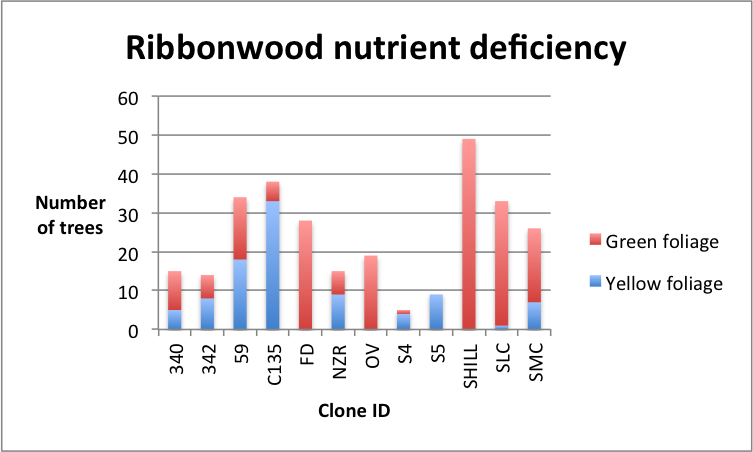Towards commercialising cypress as a high-value plantation forest species
Report Date: March 2017
Author: Dean Satchell, Sustainable Forest Solutions, R.D. 1 Kerikeri, Northland 0294
+64 9 4075525
In memory of Allan Levett, cypress enthusiast and advocate for this research project
Special thanks and acknowledgement go to:
- MPI Sustainable Farming Fund
- Cypress Development Group (NZFFA)
- Brian & Barbara Gibson
- Ben McNeil & family
- Andy & Tinks Pottinger
- Vaughan & Jude Kearns
- Angus Gordon
- Jeremy Thomson & Sashil Dayal
- Glenn Crickett & Catherine van Paassen
- Allan & Gail Laurie
- Neil & Pam Cullen
- John and Robyn Fairweather
- John Moore
- Charlie Low
- David Henley
Results
Clones and Sites
Significant differences were recorded between overall performance of clones (p<0.001), health of clones (p<0.001) and growth & form of clones (p<0.001).
Average scores for each clone for all sites »
Significant differences were recorded between sites in terms of overall performance of clones (p<0.01), health of clones (p<0.001) and growth & form of clones (p<0.001).
Average scores for each site for all clones »
- Average overall score across all sites and clones »
- Average health score across all sites and clones »
- Average growth and form score across all sites and clones »
Clone by Site Interactions
Overall performance
For overall performance, significant interactions were observed between clone and trial location (p<0.001). That is, the overall performance score for the clones varied across the sites. For example, clone 296 performed well relative to other clones at the Gisborne, Balclutha, Waimate and Wairarapa sites, but had a poor overall score relative to other clones at the Bay of Plenty and Ribbonwood sites.
Overall Scores, clone by site»
Diameter growth
For diameter growth, significant interactions were observed between clone and trial location (p<0.001). That is, the relative diameter growth of the clones varied across the sites.
Health
For overall health of clones, foliage health score and stem health score, significant interactions were observed between clone and trial location (p<0.001).
For foliage health of clones, significant interactions were observed between clone and trial location (p<0.001).
For stem health of clones, significant interactions were observed between clone and trial location (p<0.001).
That is, the Health measures all varied across the sites.
Health Scores, clone by site»
Growth and form
For overall growth & form of clones, significant interactions were observed between clone and trial location (p<0.001). That is, the relative score for overall growth and form of the clones varied across the sites.
Growth and Form Scores, clone by site»
In summary, clone by site interaction was significant, with relative performance by clones varying significantly across sites. Different sites have different rates of growth for the same clone, and different clones have different rates of growth in the same site.
Climatic influence on performance of clones
Statistical analysis was undertaken for both climatic influence on tree response to climatic variables along with clone interactions with climatic variables.
Overall performance
The most important variable explaining variation in overall performance were mean winter rainfall and mean annual rainfall. Interactions between overall performance by clone and climatic explanatory variables showed mean summer rainfall, mean winter rainfall and mean summer temperature to be the most important variables explaining variation in overall performance between clones. That is, overall performance variability between clones differs by climatic influence, in particular rainfall.
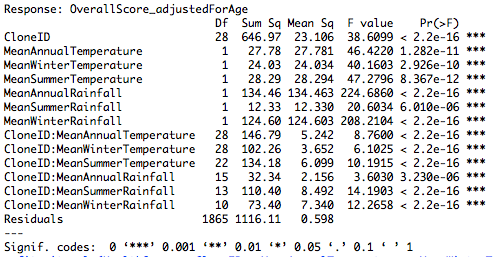
Tree health
The most important variables explaining variation in tree health were mean winter rainfall and mean annual temperature, followed by mean annual rainfall and mean summer rainfall. Rainfall and temperature in general significantly affected overall variation in tree health. Interactions between tree health by clone and climatic explanatory variables showed rainfall and temperature to be important variables explaining variation in clone health. That is, relative health scores for clones are heavily influenced by climatic variables.
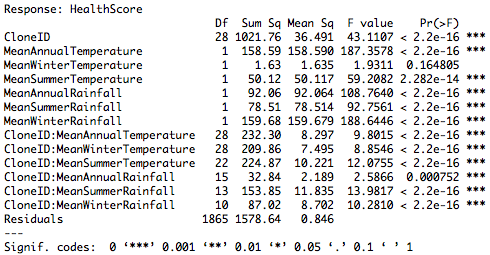
Diameter growth
The most important variables explaining overall variation in diamater growth was mean winter temperature, followed by mean annual temperature, then mean summer and mean winter rainfall. Interactions between diameter growth by clone and climatic explanatory variables showed mean annual temperature, mean summer rainfall and mean winter rainfall to be the most important variables explaining variation in diameter growth, with temperature and rainfall both significantly influenced variability between clones. That is, relative diameter growth of clones is heavily influenced by climate.
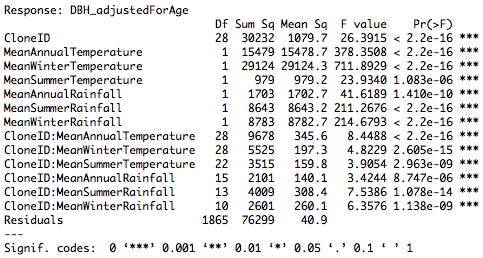
Growth and form
The most important variables explaining variation in growth & form score was mean annual rainfall, followed by mean winter rainfall. Interactions between growth & form by clone and climatic explanatory variables showed temperature and rainfall both significantly influenced variability between clones, but in particular mean summer rainfall and mean winter rainfall. That is, relative growth & form scores for clones are heavily influenced by all climatic variables, but in particular rainfall.
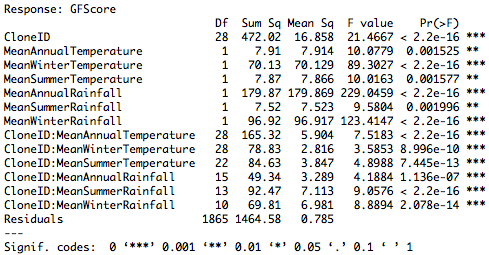
Relationship between Growth & Form and Tree Health
A statistically significant relationship was observed between the Growth & Form score and the Health score (p<0.001).
Furthermore, diameter was significantly associated with form (p<0.001), foliage health (p<0.001), stem health (p<0.05) and overall health (p<0.001).
That is, a large tree at age 20 generally has good form and health and a small tree poor health.
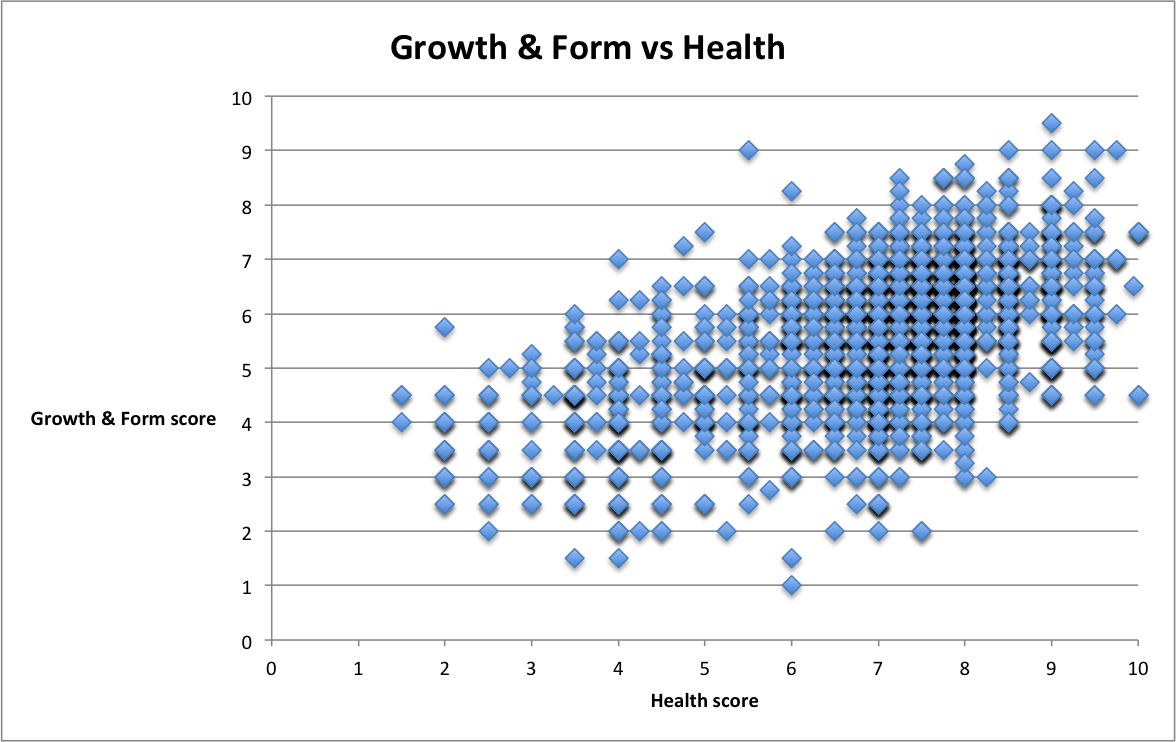
Toppling and Clones
At one site (Waimate) a significant number of trees had toppled during a severe storm event in 2013. Clones were planted in blocks and it was observed that certain clones appeared to be consistently prone to toppling. Clones were recorded as "toppled", "not toppled" and "snapped" (where the tree had snapped at the base).
A number of clones showed a statistically significant propensity for toppling, as displayed below in the "R" statistical software output:
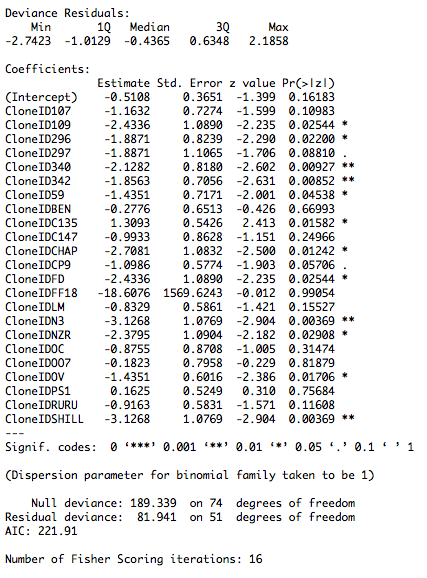
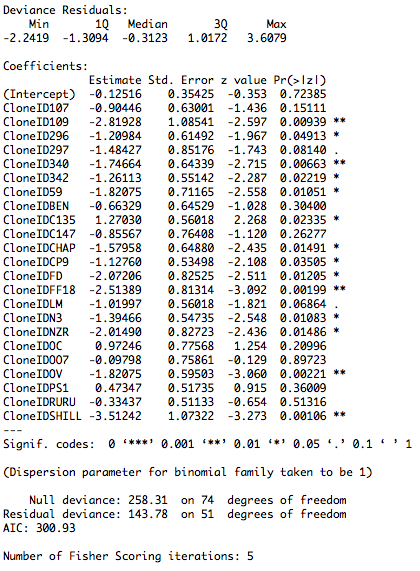
This result shows that some clones are more likely to topple and break than others. This is an important result demonstrating that longer-term selection of clones with a low propensity for toppling is important in breeding programmes.
Nutrient deficiency and differences between clones
At one site (Ribbonwood) growth appeared to be limited in some clones more than others by what appeared to be a soil nutrient deficiency expressed as yelowing of the foliage and slow growth. This was variable across the site with trees of the same clone sometimes holding better foliage colour and growth in one area and poor foliage colour and poor growth in another. Other clones appeared less affected by this variability, in particular the leyland hybrids. Testing the hypothesis that relative performance under nutrient deficient conditions varies between clones, the "R" statistical software output showed this to be the case:
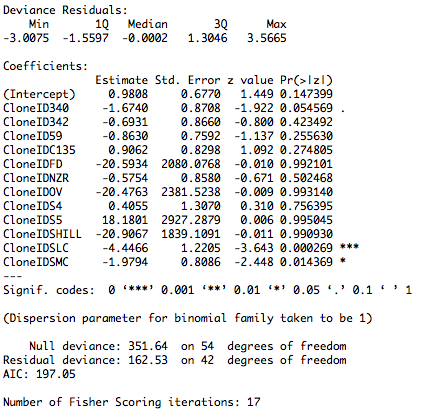
In particular, clones "SMC" and "SLC" were significantly variable across the site compared with other clones. The Nootkatensis hybrid clones Ferndown (FD), Ovensii (OV) and Stapehill (SHILL) did not vary across the site and foliage was consistently green. Clones C135, 55 and 54 were consistently yellow across this site and with poor growth, indicating a nutrient deficiency. This finding suggests that different clones can be selected for suitability to variable nutrient status in the soils.
